Study on the Supply Efficiency of Rural Public Service in China Based on Three-stage DEA M odel
Zongbing DENG,Chaoying WU,Junliang Zhang,Ju WANG
1.The Research Center of Rural Economy and Management,Southwest University,Chongqing 400715,China;2.College of Economics and Management,Southwest University,Chongqing 400715,China
Solving the serious shortage of public services in rural areas is a key to achieving coordinated urban and rural development and building awell-off society in rural areas.At present,there are two possible reasons for the severe shortage of public services in rural areas of China:one is the inadequate investment in public services in rural areas;the other is the existence of no efficiency in the supply process,resulting in more investment but less output.A lot of literature examines the explanatory power of the first reason,and believes that the government has policies biased against rural areas in the process of fiscal expenditure[1-4];but for the second reason,the supply efficiency of rural public service has not yet been concerned about[5-7].Then,under the practical constraints of relative shortage of total financial investment in China's rural public service,how to improve the input and output efficiency effect through the improvement of the supply efficiency of rural public service,is of a pivotal significance to the realization of the national established development goals of rural public utilities.
1 Literature review
Public service itself has the characteristics of public welfare,so we can not measure its efficiency totally according to the costs and benefits(Gong Feng,2008)[8].However,if the providers of public services in rural areas are seen as the decision-making unit(DMU)of public service,then the data envelopment analysis(DEA)widely used in the business efficiency evaluation,can be applied to the assessment of the productivity of rural public service providers.
At present,most domestic scholars have complied with this idea,to select the input and output indicators to evaluate the efficiency of public services.Zhang Ning et al.(2006)[15]used two stage DEA method to evaluate the healthy productivity in China;Cai Yuezhou and Chen Changsheng(2007)[16]used the classical DEA model to assess the Chinese provincial supply efficiency of public safety services;Sun Lu and Wu Ruiming(2007)[17]used the classical DEA model to carry out the comparative analysis of basic public service performance in 16 cities in the Yangtze River Delta;Guan Xinshuai and Wang Siwen(2009)[18]used the two stage DEA method to study the regional differences in the supply efficiency of local public goods and the influencing factors;Xu Jingqin and Yang Yongheng[19]measured the supply efficiency of the Chinese mainland provincial government basic public services and the influencing factors based on two-stage DEA method;Liujiang[20]used two-stage DEA method to study the supply efficiency of regional public goods and the influencing factors.There are some scholars using DEA technique to assess the supply efficiency of rural public service.Zhu Yuchun et al.[5]used the classical DEA method to research the supply efficiency of rural public service and the regional differences in 28 provinces(autonomous regions and municipalities)of China during the period 2005-2007,and found that the rural public service efficiency in China showed the characteristics of regional gradient variation;Li Jianjun et al.[21]used the two-stage DEA method to study the supply efficiency of public goods in 135 counties of Sichuan Province and the influencing factors,and the results showed that the complex geographical environment reduced the supply efficiency of public goods,and the increasing township areas and population increase contribute to the improvement of supply efficiency;Deng Zongbing et al.[6]used two-step DEA method to carry out the empirical analysis of the supply efficiency of rural public goods in Chongqing and its influencing factors,and the results showed that the supply efficiency was significantly positively correlated with the proportion of primary industry,the income of rural residents,but not significantly correlated with road density and urbanization rate.
Overall,the domestic use of DEA method to study public services started late,especially for the problem of supply efficiency of rural public service,and it is mainly based on the classic DEA two-step method.The classic two-step DEA method never considers the possible impact of environment of decision-making unit,external shocks,measurement error and variable omission,so the efficiency values obtained may be underestimated or overestimated[10].In addition,the existing researches focus on the estimation of the supply efficiency of rural public service,and there is a relatively shortage of studies on the supply efficiency of rural public service and its influencing factors.In view of this,this article will use the three-stage DEA approach to carry out the empirical analysis of the supply efficiency of rural public service in China's31 provinces and regions.Firstly we use CCR model in the three-stage DEA method to measure the supply efficiency of rural public service in 31 provinces and regions of China,decompose the supply efficiency of rural public service into technical efficiency,pure technical efficiency and scale efficiency,and then use SFA model to identify the environmental factors affecting the supply efficiency of rural public service.After eliminating the environmental factors,we re-construct the CCR model to re-estimate the supply efficiency of rural public service in China's 31 provinces and regions,and put forth the relevant policy recommendations for improving the rural public service efficiency.
2 Research methods and data description
2.1 Research methodsThe three-stage DEA model is amodi-fied DEA model proposed by Fried et al.(2002)[22],and the biggest advantage is the ability to eliminate the environmental factors affecting efficiency and random error,to get the efficiency values that only reflect the level of management,to better evaluate the efficiency of DMU.Its construction consists of three stages:where xjand yjare the input and output indicators for the DMUs;λjis the combination coefficient of the DMUs;ξ is non-Archime-dean infinitesimal;eTis the unit row vector;θ is efficiency coefficient;s+and s-are slack variables.The estimated value is the value of technical efficiency,and can be decomposed into pure technical efficiency and scale efficiency.
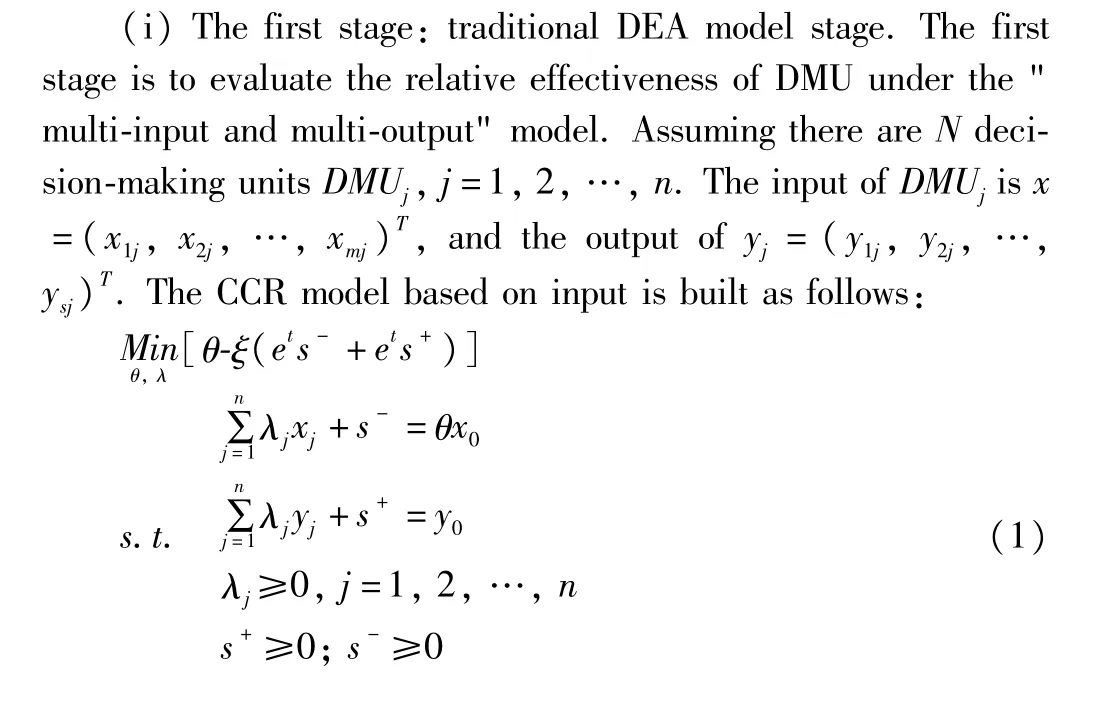
(ii)The second stage:decomposition of input differences at the first stage.The SFA regression model is used to decompose the input differences calculated at the first stage,namely the difference between the actual DMU input and the input into the efficiency frontiers,denoted by[x-X]≥0.This difference is affected by environmental factors,random interference and management inefficiency.It is expressed as follows:
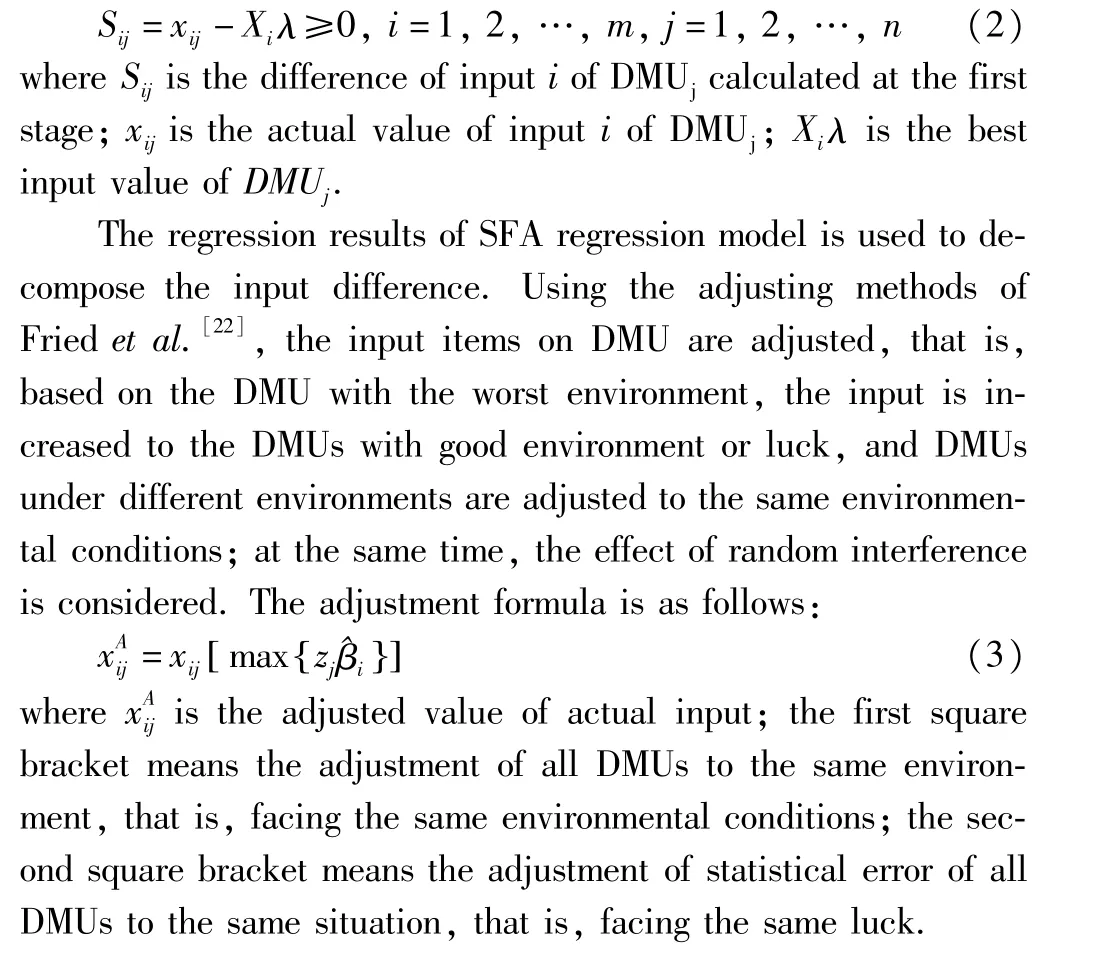
(iii)The third stage:adjusted DEA model.The adjusted input data obtained at the second stage is used to replace the original input data,and the output is still the raw output data.The supply efficiency of public service is assessed again,and the efficiency value of various DMUs obtained at this time is the efficiency value eliminating the effects of external environmental factors and random factors.
2.2 Indicator selection
2.2.1Selection of DEA model input-output variables.Based on the relevant literature[5-8]and taking into account the data availability,this article takes water conservancy for farming and forestry,rural education and rural health care(three rural public services directly related to rural well-being and livelihood)as the study object.The following indicators are selected as the input indicators:financial expenditure on water conservancy for farming and forestry in the provinces or autonomous regions(108yuan),financial expenditure on rural education in the provinces or autonomous regions(108yuan),and the number of rural medical institutions in the provinces or autonomous regions(108yuan).
Correspondingly,the following indicators are selected as the output indicators:total output value of farming,forestry and aqua-culture in the provinces or autonomous regions(108yuan),the number of students in rural schools in the provinces or autonomous regions(104people),and the number of rural health personnel in the provinces or autonomous regions(104people).
2.2.2Selection of the external environment variables at the second stage of DEA.As to the environmental variables,we should choose the factors having a impact on the rural public service efficiency in the provinces but not within the subjective controllable range of sample,including economic development,social environment,related policies,population size,the educational level of residents,and other factors.In economic development,the studies of Borger and Kerstens[23]showed that in the regions with higher level of economic development,it was easier to cause a waste of public funds.Migue and Belanger(1974)[24]believed that in the regions with higher level of residents' income,the political influence of the residents would be higher,and it was easier to force the government to provide efficient government services.In this paper,we use the level of rural per capita income in various provinces or autonomous regions to measure the level of economic development,and expect that the improvement of the level of rural per capita income plays a positive role in enhancing the rural public service efficiency.In demographic factors,the studies of Atha-nasso poulos and Triantis[25]showed that population density and population size had a negative impact on the supply efficiency of public service,and Loikkanen and Susiluoto[26]held the same view.However,the studies of Grossman et al.[27]showed that the regional population density was negatively correlated with the government administration and monitoring costs,that is,there was scale effect in the public service provided by the government.In this paper,we use population density and population size to measure,but the relationship between the two variables and improvement of rural public service efficiency is uncertain.In the educational level of residents,we choose the proportion of the number of rural secondary school students to rural population in the provinces or autonomous regions to measure.The studies of Davis and Hayes[12]showed that the spending efficiency of local government depended on the ability of local residents to put pressure on the government,and believed that the education level of the local population was a good proxy variable for this ability.Afonso and Aubyn(2005)[28]pointed out that for the residents with higher education level,their quality and ability to participate in the politics would be stronger,and the higher education level could improve the ability of residents to identify and monitor government's behavior.It is expected that the improvement of educational level of the farmers will help to enhance rural public service efficiency.In the policy,we choose the proportion of financial expenditure on rural public service to GDP of various provinces or autonomous regions to measure.Given the fiscal policy is an important policy in the supply of rural public services,the increase in the fiscal spending in the context of low level of fiscal spending on public service at present,will play a positive role in supplying rural public services.However,the studies of Zhang Ning,Hu Angang and Zheng Jinghai[15]showed that the public health spending was not significantly correlated with the healthy productivity in China,and in the regions with higher proportion of expenditure on public health,the healthy productivity was often lower.
Thus,the relationship between increase in the proportion of fiscal expenditure on rural public service to GDP of various province or autonomous regions,and improvement of rural public service efficiency in various province or autonomous regions,needs to be empirically tested.
2.3 Data descriptionGiven the integrity and availability of data,we choose the rural public service input and output in 31 provinces(cities,regions)in 2011 as the sample.Each province is regarded as one DMU,and there is a total of31 DMUs.Based on differences in economic development and characteristics of geographic distribution,the 31 provinces(cities,regions)are divided into eastern,central and western regions.The data in this article are from China Statistical Yearbook 2011,China Education Statistical Yearbook 2010 and Chinese Health Statistical Yearbook 2011.
3 Result analysis
3.1 The traditional DEA empirical results at the first stageThe DEAP2.1 software is used to analyze the level of rural public service efficiency and the state of returns to scale in 31 provinces and regions of China in 2011,and the results are shown in Table 1.As can be seen from Table 1,without considering the external environment variables and random factors,the average technical efficiency of rural public service supply was 0.826 in China's 31 provinces and regions in 2011;the average pure technical efficiency was0.906;the average scale efficiency was 0.901,indicating that the technical efficiency of rural public service supply was relatively low,and there was18.4%of room for improvement.It can also be seen from Table 1 that only Beijing,Shanghai,Liaoning,Heilongjiang,Shandong,Henan and Hubei are at the technical efficiency frontier,accounting for only 22.58%of 31 provinces((municipalities,autonomous regions),and there are varying degrees of improvement room in the supply efficiency of rural public service in remaining 24 provinces and regions.
In addition,there are significant differences in the supply efficiency of rural public service between the provinces and regions.For Beijing and Shanghai at the technical efficiency frontier,the technical efficiency is1,while for Tibet,the technical efficiency is the lowest(0.451).The former is2.22 times the latter.Overall,the current supply efficiency of public services in rural areas is not good and there are significant differences between provinces.
From the point of view of returns to scale,7 DEA effective provinces and regions are at the stage of constant returns to scale,indicating that the input-output ratio of rural public service in the 7 provinces and regions achieves the optimal state;for the rest of the 24 provinces and regions,there are 21 at the stage of increasing returns to scale,indicating that there is greater room for improvement of scale efficiency in the 21 provinces and regions;Jiangsu,Hunan and Guangdong are at the stage of decreasing returns to scale,indicating that the improvement focus of the supply efficiency of rural public service for these provinces lies in the improvement of the management level.Overall,the input scale of rural public service in the majority of provinces and regions is small,so the supply efficiency of rural public service can be improved by expanding the supply scale.
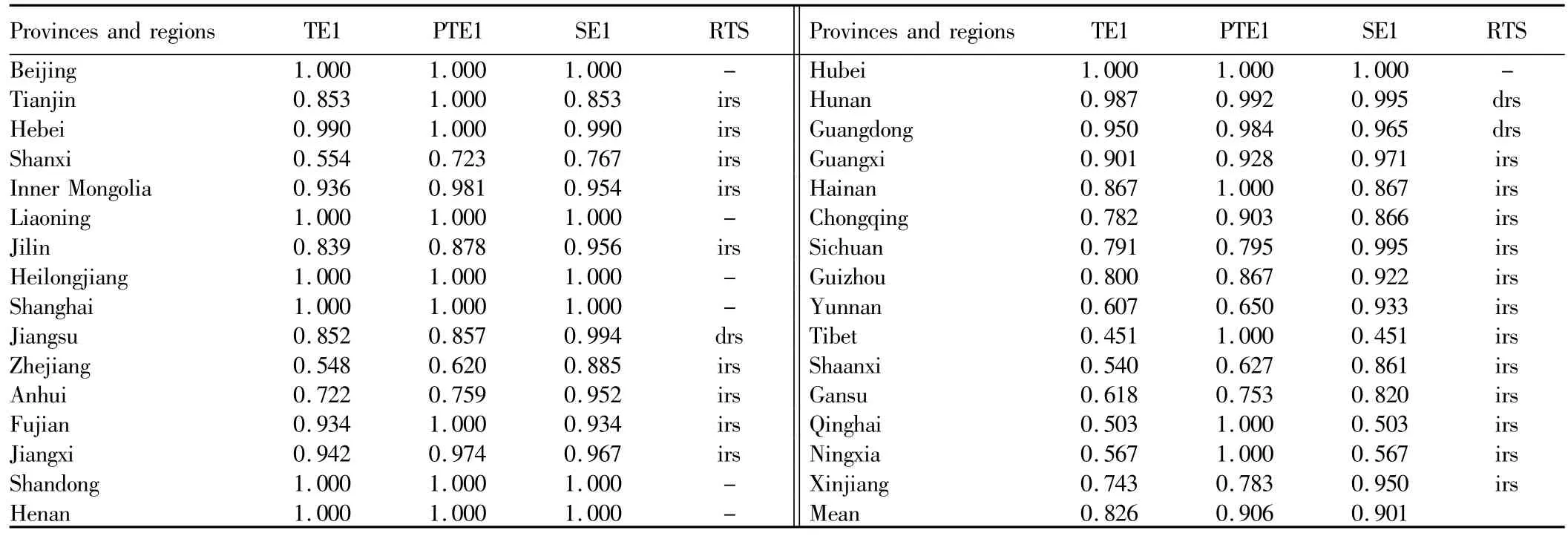
Table 1 The supp ly efficiency,pure technical efficiency and scale efficiency at the first stage of rural public service in various province or autonomous regions in 2011
3.2 SFA regression results at the second stageThe slack variables of various inputs in the DMUs derived at the first stage are regarded as the variables to be explained,and the afore-mentioned 6 environmental variables are regarded as explanatory variables.The SFA regression results from the Stata10.0 can be shown in Table 2.
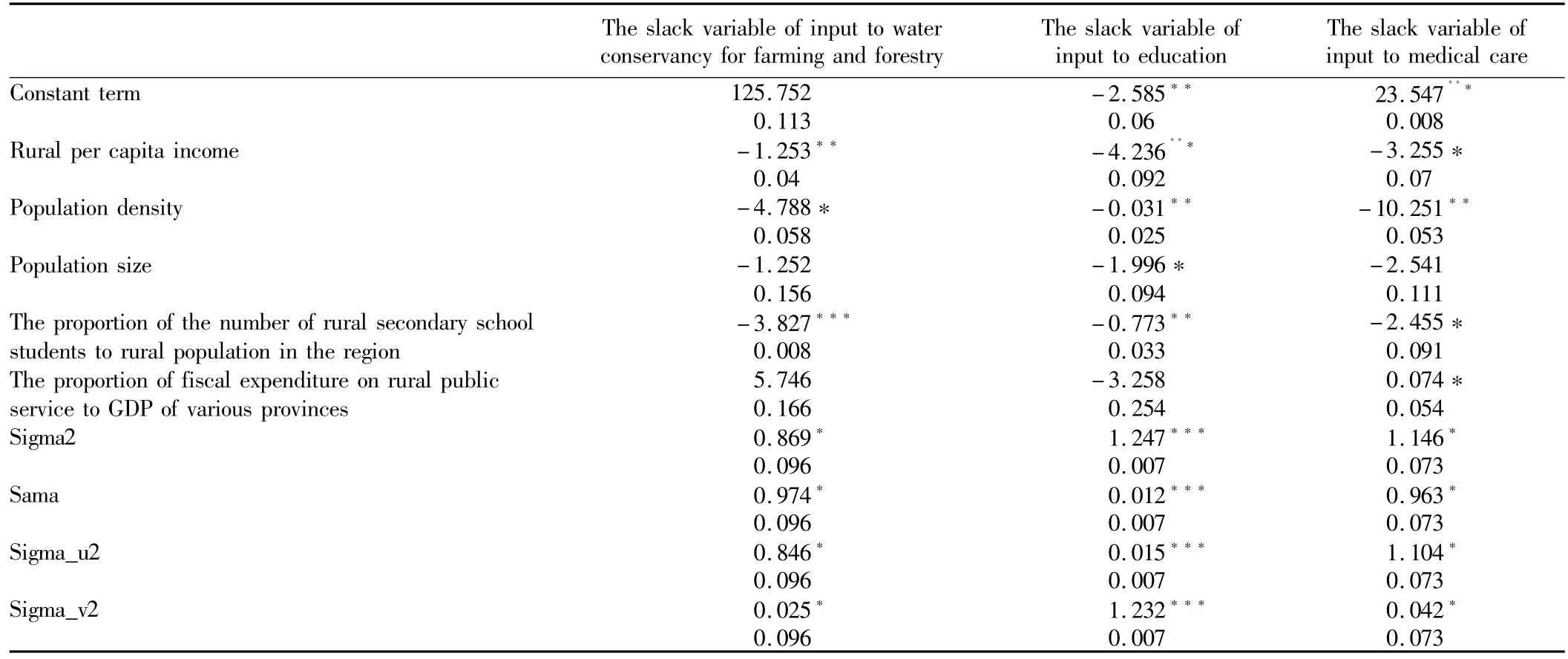
Table 2 The regression results of the slack variables of input at the second stage and external environmental factors
Table 2 shows that among the 5 environmental variables,the regression coefficients of 3 environmental variables(rural per capita income,population density,and the proportion of the number of rural secondary school students to rural population in the region)on 3 input slack variables pass the test at10%,5%or1%significance level;the regression coefficients of remaining 2 environmental variables(population size and the proportion of fiscal expenditure on rural public service to GDP of various provinces)on some input slack variables can pass the test at 10%,5%or 1%significance level.Clearly,the external environmental factors have a significant impact on the input redundancy of rural public service supply in China's provinces and regions.
γ value of slack variables of input to water conservancy for farming and forestry and input to medical care is 0.974 and 0.963,respectively,and passes10%significance test,indicating that the management factors in the input to water conservancy for farming and forestry and medical care play a leading role;γ value of slack variables of input to education is 0.012,and passes 1%significance test,indicating that the random factors play a dominating role.So we can see that the management factors and random factors have a significant impact on the supply efficiency of rural public service in China's provinces and regions,and it is necessary to use SFA to exclude the impact of management factors and random factors on the supply efficiency of rural public service in China's provinces and regions.We further examine the coefficients of various environmental factors on 3 input slack variables.The environment variables are the regression of various input slack variables,so when the regression coefficient is negative,it indicates that increasing the value of the environment variable helps to reduce the input slack,conducive to reducing the waste of input variables or the negative output;on the contrary,when the regression coefficient is positive,it indicates that increasing the value of the environment variable will increase the input slack,thereby resulting in the waste of input variables or output reduction.
Now we elaborate the impact of environmental variables on input slack variables.
(i)Level of rural per capita income.As can be seen from Table 2,the coefficients of this variable on the3 input slack variables are negative,and pass 10%significance test.It indicates that when the level of rural per capita income is increased,the 3 input slack variables will be reduced,thereby increasing the supply efficiency of rural public service in various province or autonomous regions.This is consistent with the expected results of this article,indicating that the supply efficiency of rural public service in the region is literally related to the farmers' income in the region.In general,when the level of farmers' income is high,the level of economic development is also high in the region,there will be more more financial and human resources for rural public service,and it is more likely to improve its rural public service system and technical conditions.The marginal efficiency of the supply of public services in rural areas is decreasing,so only by the higher incomes can we stimulate farmers to consume rural public service on a large scale,and enhance their enthusiasm for production of quasi-public goods,thereby improving the supply efficiency of rural public service.
(ii)Population density and population size.Demographic factors include two indicators(population density and population size).The coefficient of population density on the 3 input slack variables is negative,indicating that when the population density is increased,the 3 input slack variables will be reduced,thereby improving the efficiency of public services in rural areas.It can be seen that there are economies of scale in the rural public service efficiency,that is,greater population density will help to spread the fixed costs in the process of supply of rural public service,and reduce the total cost of public services in rural areas,thus showing relatively high efficiency,which is consistent with the hypothesis in this article.The coefficient of population size on the 3 slack variables is also negative,and the coefficient of it on educational input slack variable passes 5%significance test,indicating that there is a"threshold effect"of population size in the improvement of the supply efficiency of rural public service.
(iii)The proportion of the number of rural secondary school students to rural population in the region.It can be seen from Table 2 that the coefficients of variable of the proportion of the number of rural secondary school students to rural population in the region on the 3 slack variables is negative,and pass 10%significance test.It indicates that when the proportion of the number of rural secondary school students to rural population in the region is increased,the3 inputs lack variables will be reduced,and the rural public service efficiency will be increased.In other words,for the farmers with higher education level,their quality and political participation ability are stronger,and higher education level can improve farmers' ability to identify and monitor the behavior of the government,which will help to improve the efficiency of public service supply in rural areas.It is in line with the expected hypothesis in this article.
(iv)The proportion of fiscal expenditure on rural public service to GDP of the provinces.The coefficients of this variable on the 3 input slack variables are not all negative,and only the slack variable of input to medical care passes 10%significance test.It indicates that the improvement of the proportion of fiscal expenditure on rural public service to GDP of the provinces plays a not significant role in enhancing the supply efficiency of rural public service.This is consistent with the research findings of Zhang Ning,Hu Angang and Zheng Jinghai(2006).There may be two reasons:First,the current local governments' fiscal expenditure on rural public service is excessively low,never crossing the"threshold effect";second,with the increasing proportion of fiscal expenditure on rural public service to regional GDP,it may lead to smaller constraint of rural public service resources,more prone to resource waste,thereby causing low rural public service efficiency.The above analysis shows that a variety of external environment variables literally have some influence on the supply efficiency of rural public service in different provinces and regions.Therefore,it is necessary to adjust the original input variables,to make all provinces and regions face the same operating environment,and examine the real rural public service supply efficiency.
3.3 DEA empirical results after adjustment of input at the third stageThe input variables are adjusted according to the adjustment formula at the second stage,and the adjusted input values and original output values are analyzed again,to get the supply efficiency value and state of returns to scale of rural public service at the third stage in various province and regions of China in 2011(Table 3).
Table 3 shows that there are great differences in the supply efficiency of rural public service in various provinces or auto no-mous regions before and after the adjustment,and it is more unsatisfactory after removal of the external environmental factors and random factors.The DEA detailed analysis at the third stage is as follows:scale.
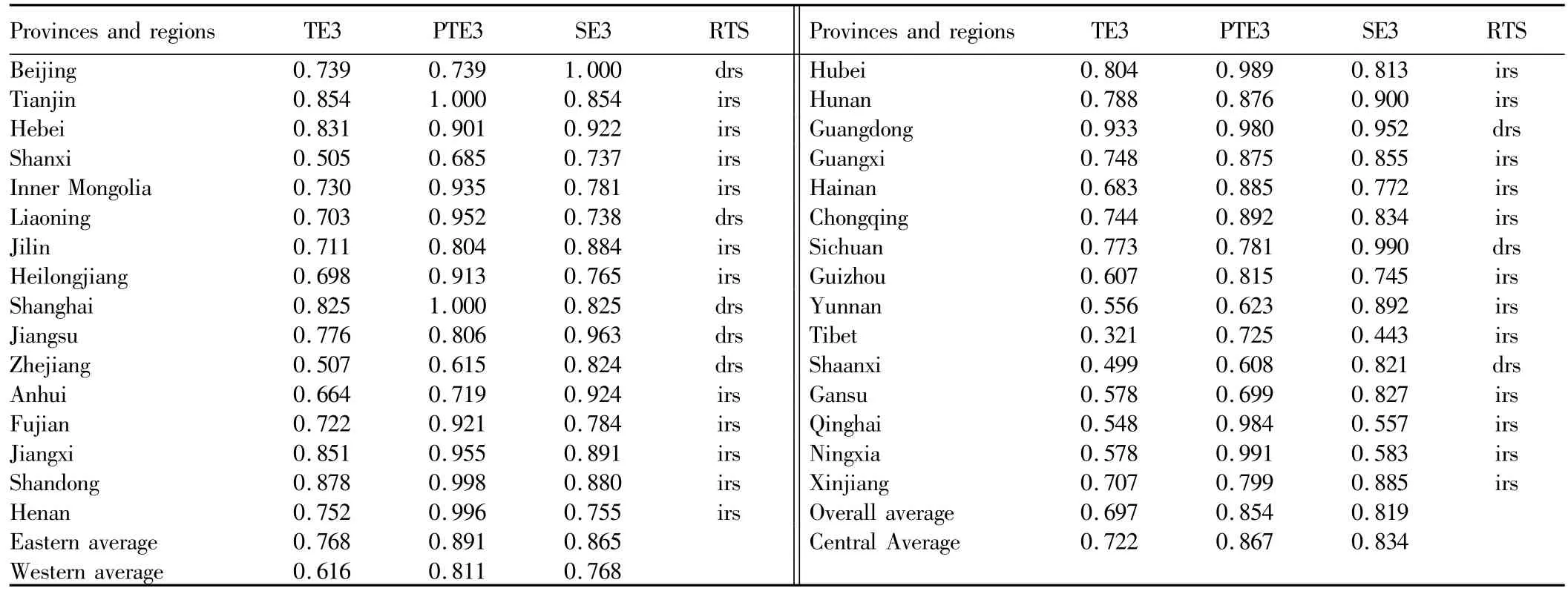
Table 3 The supply efficiency,pure technical efficiency and scale efficiency of rural public service at the third stage in various province and regions of China in 2011
(i)Technical efficiency.Technical efficiency scores can measure the overall efficiency of rural public service.From Table 3,we know that there are great changes in the technical efficiency of rural public service supply before and after the adjustment,and the adjusted technical efficiency of most provinces and regions is lower than before.From the effective DMUs,the provinces and regions at the frontier of technical efficiency are greatly reduced after adjustment,because the decline in the pure technical efficiency or scale efficiency leads to decline in technical efficiency,thereby withdrawing from the technical efficiency frontier.Overall,the average of adjusted technical efficiency of rural public service supply was only 0.697 in 2011,still having 30.3%of room for improvement.
(ii)Pure technical efficiency.Pure technical efficiency is used to measure the degree of ineffective rural public service caused by the purely technical factors.Table 3 shows that except Tianjin,Shanghai and Xinjiang,the adjusted pure technical efficiency value is smaller than before in the remaining 28 provinces and regions.It indicates that for most provinces and regions,low pure technical efficiency of rural public service supply is not only affected by the luck or the environment,but also closely related to irrational regional planning and unscientific management.
(iii)Scale efficiency.Scale efficiency is used to measure the gap between current production scale of DMUs and optimal production scale.If the scale efficiency score is closer to 1,the production scale will be closer to the optimal production scale.Table 3 shows that except Beijing,Tianjin,Gansu,Qinghai and Ningxia,the adjusted scale efficiency value is smaller than before in the remaining26 provinces and regions.Overall,the average adjusted scale efficiency of rural public service supply in various province or autonomous regions was only 0.819 in 2011,still having 19.1%of room for improvement.
(iv)Returns to scale.From Table1 and Table 3,before adjustment,7 provinces and regions were at efficiency frontier,and returns to scale remained constant;Jiangxi,Hunan and Guangdong were in the state of decreasing returns to scale;the remaining 21 provinces and regions were in the state of increasing returns to scale.After adjustment,the returns to scale of rural public service in Beijing,Shanghai and other economically developed provinces and regions were in the decreasing phase,while the returns to scale of Henan,Guizhou and other mid west provinces and regions were still in the increasing phase due to the economic and historical factors as well as long-term insufficient input to public service.It indicates that the scale of rural public service in underdeveloped central and western provinces and regions is still smaller than the optimal production scale,that is,the scale efficiency still has large room for improvement;the key to improvement of the supply efficiency of public service in relatively developed eastern provinces and regions lies in limiting blind investment,regulating the quality and quantity of input factors,and rationally integrating the rural public service resources in the region.
4 Further discussions:regional differences in the efficiency of public services in rural areas
4.1 Comparative analysis of the efficiency of the eastern,central and western regionsBefore removing the external environment factors and random factors,the supply efficiency of rural public service of eastern regions is roughly equal to that of central regions,and even the rural public service efficiency of some central provinces and regions is slightly higher than that of eastern re-gions;the supply efficiency of public service is the lowest in the western regions,and except the7 provinces and regions with technical efficiency of 1,the returns of rural public service are in increasing phase in 22 provinces and regions among the remaining25 provinces and regions.After removing the influence of external factors,the supply efficiency of rural public service of eastern regions becomes the highest,followed by central regions,and western regions.The rural public service efficiency is still the highest in the eastern regions,indicating that in terms of rural public service,the real efficiency of the eastern regions is literally higher than that of the central and western regions.It can be also found that the returns to scale in economically developed eastern regions are generally in the decreasing phase,while the returns to scale in relatively underdeveloped central and western regions are generally in the increasing phase,indicating that the input scale of rural public service in the central and western regions is still not large enough.
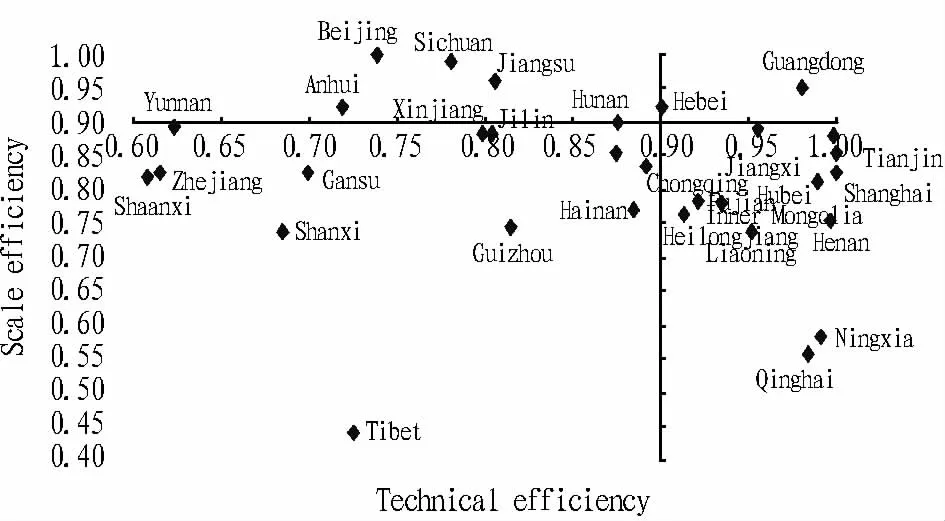
Fig.1 The spatial scatter diagram of pure technical efficiency and scale efficiency rural public service in 31 provinces and regions of China
4.2 Cluster analysis of efficiency of 30 provinces,cities and regionsWith efficiency value of 0.9 as the critical point,we can divide the supply efficiency of rural public service in 31 provinces and regions of China into four types according to the pure technical efficiency and scale efficiency.The spatial scatter diagram is shown in Fig.1.The first type is"double-high",namely the provinces and regions with pure technical efficiency and scale efficiency both higher than 0.9.Fig.1 shows that only Hebei and Guangdong fall within this type,and the supply efficiency of rural public service in this type of province needs to be little improved.The second type is"high-low",namely the provinces and regions with pure technical efficiency greater than 0.9 but scale efficiency lower than 0.9.12 provinces including Henan and Jiangxi fall within this type.These provinces and regions are mostly economically underdeveloped provinces and regions,and the key to improving these provinces and regions is to expand the scale of rural public service supply when the financial conditions permit.The third type is"low-high",namely the provinces and regions with pure technical efficiency smaller than 0.9 but scale efficiency greater than 0.9.5 provinces and regions including Sichuan and Beijing fall within this type,and these provinces and regions should lay great emphasis on pure technical efficiency improvement in the future development,namely pay attention to the improvement of management level in supply of public services.The fourth type is"double-low",and 12 provinces and regions including Shaanxi,Guizhou and Xinjiang fall within this type.These provinces and regions should focus on improving the management level and expanding the public service scale in the future public service supply.
5 Conclusions and policy recommendations
5.1 Conclusions(i)There are significant changes in the supply efficiency of rural public service in various provinces and regions before and after the adjustment at the second stage,indicating that the environmental effects and random error literally have a significant impact on the supply efficiency of rural public service.(ii)There is a need to improve the environmental factors,to promote the efficiency of public services in rural areas.SFA regression results indicate that environmental factors and random factors have a significant impact on efficiency,and the improvement of level of rural per capita income,population density and education level of farmers can significantly improve the rural public service efficiency.(iii)The scale efficiency losses of rural public service are serious.After removing the influence of environment variables and random factors,the average technical efficiency,pure technical efficiency and scale efficiency of rural public service in 31 provinces and regions decline significantly,and there are also significant changes in the returns to scale before and after the adjustment.(iv)The supply efficiency of rural public service of31 provinces and regions can be divided into"double-high","high-low","low-high"and"double low",and there are only 2 provinces falling within this type.
5.2 Recommendations(i)According to the SFA adjustment at the second stage,we know that the increase in the rural per capita income can help to improve the supply efficiency of rural public service.Therefore,we should earnestly focus on improving farmers' income while promoting healthy and sustainable development of the local economy.Population density is significantly correlated with the supply efficiency of rural public service,so each region should raise the level of concentration of residents when the environment permits.The education level is positively correlated with public service efficiency,so constantly improving the educational level of rural residents is one of effective ways to improve the rural public service efficiency.The improvement of the proportion of fiscal expenditure on rural public service to GDP plays a small role in improving the rural public service efficiency,but it does not mean that the fiscal expenditure on rural public service should be reduced.The reason may lie in the low overall level of fiscal expenditure on China's rural public service.So it is necessary to increase the fiscal expenditure on rural public service in the whole country and especially western regions.(ii)Given the differences in the characteristics of rural public service efficiency in various provinces and regions,each region should make every effort to improve the pure technical efficiency or scale efficiency to enhance the internal growth momentum for rural public service efficiency according to its type.
[1]HE JH,YUE HY,YANG RM,et al.A study on the satisfactory degree of rural public service[J].Chinese Public Administration,2006(5):91-95.(in Chinese).
[2]LINWL.The structural imbalance between supply and demand of rural public services:Phenomenon and causation[J].Management World,2007(9):62-68.(in Chinese).
[3]KONG XZ,TU SW.Demand preference and constraints to provide public goods required in our new socialist countryside:A case of irrigation and water conservancy facilities[J].Issues in Agricultural Economy,2006,27(10):10-15.(in Chinese).
[4]CHEN SY,ZHANG J.Research of local governments' fiscal expenditure efficiency in China:1978-2005[J].Social Sciences in China,2009(2):65-78.(in Chinese).
[5]LIYL.Empirical study about the supply efficiency of rural public goods[J].Journal of Public Management,2008(2):14-23.(in Chinese).
[6]ZHU YC,TANG JL,LIUCM.Evaluation on rural public service efficiency based on DEA in China[J].China Soft Science,2010(3):37-43.(in Chinese).
[7]DENG ZB,ZHANG JL,FENG YG.The supply of rural public goods efficiency evaluation and influence factors of Chongqing City[J].Journal of Sichuan Agricultural University,2013(2):233-238.(in Chinese).
[8]GONG F.Supply efficiency evaluation of local public security service——Based on the empirical study of DEA of four-stages and Bootstrapped DEA[J].Management World,2008(4):80-90.(in Chinese).
[9]P.W.Ingraham.Publicmanagement organizational reform pattern[J].Public Administration Review,1993,22(3):14-17.
[10]Andrew C.Worthington.Cost efficiency in Australian local government:A comparative analysis of mathematical programming and econometrical approaches[J].Financial Accounting and Management,2000,16(3):201-221.
[11]Antonio Afonso,Sonia Femandes.Measuring local government spending efficiency:Evidence for the Lisbon Region[J].Regional Studies,2006,40(l):39-53.
[12]Michael Davis,Kathy Hayes.The demand for good government[J].Review of Economic sand Statistics,1993(175):148-152.
[13]Kevin Milligan,Enico Moretti,Philip Oreopoulos.Does education improve citizenship Evidence from the United States and the United Kingdom[J].Journal of Public Economics,2004,88(9-10):1667-695.
[14]Retzlaff-Roberts D.,C.F.Chang,R.M.Rubin.Technical efficiency in China Normal University,2012.(in Chinese).
[15]ZHANG N,HU AG,ZHENG JH.Using data envelopment analysis approach to estimate the health production efficiencies in China[J].Economic Research Journal,2006,41(7).92-105.(in Chinese).
[16]CAIYZ,CHENCS.Chinese Government's public service:The basic value orientation and comprehensive performance appraisal[J].Public Finance Research,2007(6):20-24.(in Chinese).
[17]SUN L,WU RM,LIY.Evaluation on performance of public service[J].Statistics and Decision,2007(24):65-67.(in Chinese).
[18]GUAN XS,WANG SW.On the measure of regional differences of China's local public goods provision efficiency[J].Journal of Lanzhou University(Social Sciences),2009,37(4):43-47.(in Chinese).
[19]XU JQ,YANG YH.On delivery efficiencies of local basic public services and its influencing factors:Based on DEA two-stage approach corrected by bootstrap[J].Finance and Trade Research,2011,22(6):89-96.(in Chinese).
[20]LIU J.Study on the efficiency of public goods' supply in China——Analysis on the differences and reasons[J].Lanzhou Academic Journal,2012(5):138-142.(in Chinese).
[21]WANG DX,ZHANG Q.Analysis of efficiency of China city government public expenditure:Empirical research based on four-stage DEA method[J].Finance&Economics,2011(3):41-48.(in Chinese).
[22]H.O.Fried,C.A.K.Lovell,S.S.Schmidt,et al.Accounting for environmental effects and statistical noise in data envelopment analysis[J].Journal of Productivity Analysis,2002,17(1-2):121-136.
[23]Bruno De Borger,Kristiaan Kerstens.Cost efficiency of Belgian local governments:A comparative analysis of FDH,DEA,and econometric approaches[J].Regional Scienceand Urban Economics1996,26(2):145-170.
[24]Simar,Leopold&Wilson,Paul Wilson.Estimation and inference in two stage,semi-parametric models of production processes[J].Journal of E-conometrics,2007(136):31-64.
[25]Antreas Athanasso poulos,Konstantino Triantis.Assessing aggregate cost efficiency and the related policy implications for Greek local municipalities[J].INFOR,1998,36(3):66-83.
[26]Loikkanen,Iikka Susiluoto.Cost efficiency of Finnish municipalities in basic service provision 1994-2002[J].Mimeo.2005.
[27]Philip Grossman,Panayiotis Mavros,Robert Wassmer.Public sector technical inefficiency in large U.S.cities[J].Journal of Urban Economics,1999,146(2):278-299.
[28]Antonio Afonso,Miguel St.Aubyn.Cross-country efficiency of secondary education provision:A semi-parametric analysis with non-discretionary inputs[J].European Central Bank working paper,2005,494(7):356-367.
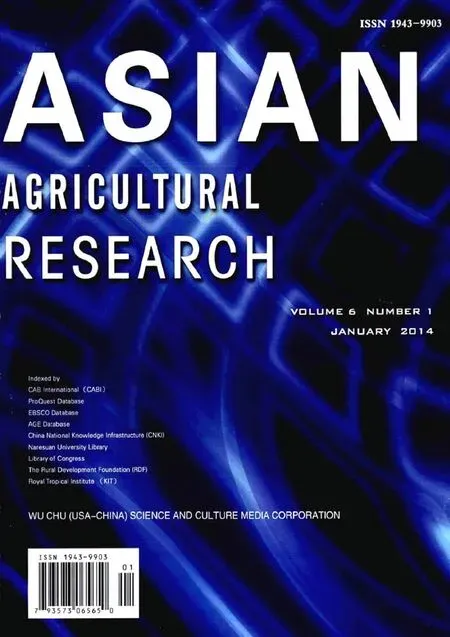 Asian Agricultural Research2014年1期
Asian Agricultural Research2014年1期
- Asian Agricultural Research的其它文章
- The Chinese Urban-rural Dual Economic Structure Model and Analysis
- Comparative Analysis of the Purchase Price of Raw M ilk in the World
- Com parative Research of Residents'Effect Perception and Participation Capacity and Willingness on Pro-poor Tourism
- Study on Performance of Development of Sports Industry in China-Based on DEA Nonlinear Estimation
- Research on the Peanut Leaf Etiolation Prevention and Film M ulching Effect in Hubei Province
- Consumers' Perception of Risks,Awareness of Products and Willingness to Pay:A Case Study of Organic Milk
